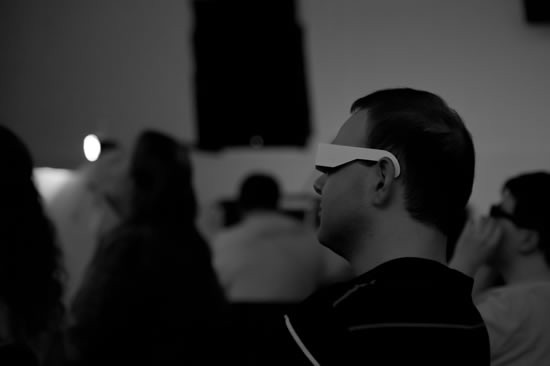Beyond the beyond is the name of Bruce Sterling’s famous blog on Wired. It’s a habit of sci-fi people to think beyond what is anticipated by the mainstream, eventually to think about how ‘change‘ or ‘beyond’ itself gets new meanings.
It seems also virtual people love to think ‘beyond’: beyond virtual worlds, avatars, machinima. That at least is the conviction I have after attending the MetaMeets conference about virtual worlds, augmented reality and video/machinima in Amsterdam. I’ll give a very fast overview of the second and last day of the conference to illustrate this.
Heidi Foster is involved in the management of a new breedable pet in Second Life, Meeroos, with a large customer base. Meeroos are mythical animals, Foster explained, but they are mostly very cute and they ask to be picked up. To be precise: the project launched on May 21 and now there are 22,000 players and 250,000 Meeroos in Second Life. It’s conceivable that the Meeroos will invade the rest of the Metaverse by spreading to other virtual worlds such as OpenSim. In the discussion it was suggested to expand to mobile devices as well. That would be awesome I think: develop and launch on Second Life, spreading throughout other virtual places and ending up on smartphones and tablets.
Not a potential but a real move to mobile devices was presented by Timo Mank, an artist-curator at the Archipel Medialab. In 1999 he co-founded Art Hotel Dit Eiland (This Island) in the Dutch village of Hollum on Ameland. The Medialab initiates Artist In Residences focused on cross reality projects. Many artists from PARK 4DTV worked on Ameland creating content for web based virtual islands. Until recently Timo was curating Playground Ameland Secondlife.
Early this year the Foundation Archipel Ameland shifted focus from yearly media art interventions to transmedia story telling for iPad. The project is called TMSP TV and it connects twitter with guests at the TMSP studio in Diabolus Artspace Secondlife. The LiveLab uses the daily on goings in the World Herritage Waddensea and brings this material as live feed to virtual space where it’s playfully reevaluated, mixed and redistilled by guests and performers.
Toni Alatalo is the CTO of a small games company, Playsign, and the current lead architect of the open source realXtend platform. He explained that not every virtual world needs avatars. Imagine a virtual environment allowing to explore the human body by traveling through the veins, or just think Google Earth. Technologically speaking avatars do not need to be part of the core code of the virtual environment, instead the code could be modular. Which could lead us indeed to virtual worlds without avatars, or to avatars in environments which are not perceived as classical virtual worlds (think augmented reality, smartphones).
Of course there were things which seemed very familiar to seasoned users of Second Life or Open Sim. Melanie Thielker (Avination) talked about roleplaying, commenting a video depicting the awesomeness of user-generated content. ‘Content’ is an awful word used by publishers when they mean all kinds of stuff such as texts, videos, infographics, images. In this case it refers to impressive builds made by users of the virtual worlds, but Melanie emphasized rightfully that the most important content items are the storylines people create, the characters they build, the backstories they provide, the communities they form. They write their own books in a very experimental, fluid, ever-changing setting.
But even this well-known practice is going somehow ‘beyond’ as it takes place in Melanie’s own virtual world, independently from Second Life. Melanie is an entrepreneur in the Metaverse.
Karen Wheatley is the director of the Jewell Theatre in Second Life. She goes beyond theatres and beyond some existing Second Life subcultures. She runs a theatre in Gor. The Gorean subculture is known for its traditions (based on novels by John Norman), is fond of a warrior ethos, (mostly) female slaves and dislikes furries (avatars with animal-like features) and kid-avatars. All of which does not prevent Wheatley to organize her Shakespearian performances in Gor, open for all avatars. She gets sponsoring and so we could consider her being an entrepreneur too.
Draxtor Despres goes beyond in various ways. In his video reportages he combines ‘real’ footage with video shot in virtual environments. He presented his newest big project: a documentary for the German public television ZDF, Login2Life which will come out mid-July. It goes beyond Second Life as it also shows World of Warcraft.
Stephen M. Zapytowski, Professor of Design and Technology at the School of Theatre and Dance of the Kent State University presented another example of crossing boundaries: April 2011 saw the premier of his avatar ghost for Kent State’s production of Hamlet. This ghost played “live†on stage with real life actors in a blend of virtual and real worlds. Which of course made the audience dream of avatars and humans playing nicely together in the augmented reality (please stay calm: we’re not there yet).
Talking about playing together: that’s what the music panel with JooZz & Al Hofmann talked about. They want even more sophisticated means for people from all over the planet to jam together in perfect synchronicity.
Chantal Gerards showed us a few machinima videos, and I sensed a bit of frustration. In one of her creations she used music from the director David Lynch. Unfortunately, he did not even want to watch the video as ‘he does not like machinima’.
Chantal said: “I have a scoop for you today. I stop making machinima”, adding a bit mysteriously that she will move ‘beyond machinima’. Her advice goes beyond machinima as well: create together, with all kinds of people and platforms, move beyond the platform so that what you create gains wider relevance.
Read also my write-up of the first day: “we are at the beginning“


